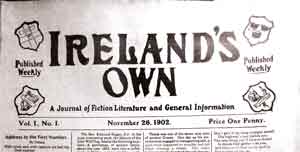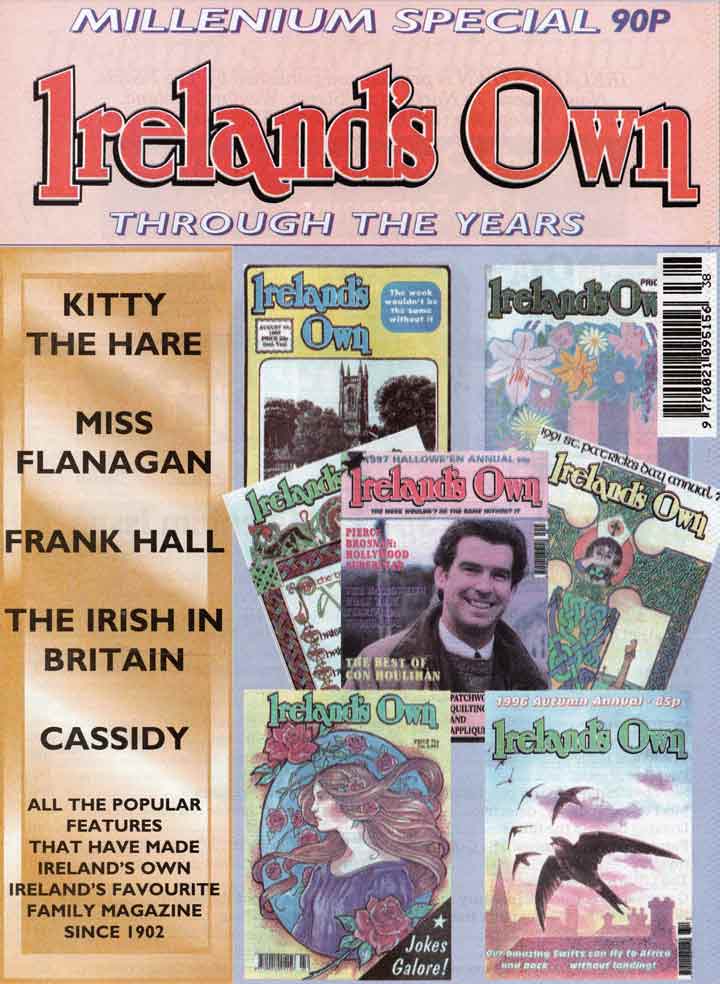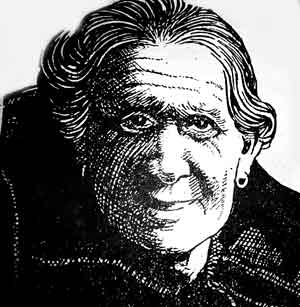IRELAND’S OWN—‘HEALTHY FIRESIDE READING’
Published in Features, Issue 4 (July/August 2022), Volume 30By Nicholas Rossiter
In 1902 people learned about the outside world through newspapers and periodicals. Lighting in the home, outside large urban areas, was by candle, oil-lamp or gas mantle. The reading material was very much text-laden, with few illustrations other than line-drawings.
Since the introduction of National Schools in 1831 there had been a steady increase in literacy. The most likely reading material was the local newspaper. In addition, newsagents would have stocked national newspapers such as the Freeman’s Journal and the British newspapers of the day. Avid readers might access Titbits or, to give its more formal name, Tit-Bits from all the interesting Books, Periodicals, and Newspapers of the World. This was one of the most popular publications of the era since its foundation in October 1881. It was a mass-circulation commercial publication on cheap newsprint, which reached sales of between 400,000 and 600,000 copies.
This may have been the inspiration for John M. Walsh, originally from New Ross, Co. Wexford, to launch an Irish rival and to ‘produce a magazine that combined the best of world information with all that was good in Ireland’. Ireland’s Own saw its role as projecting an image of Ireland free from ‘alien’ influence, hence with content free from anything perceived as ‘scandalous’ or ‘anti-Catholic’. A critic described such magazines as offering ‘a formula for “healthy fireside reading” combining patriotism, pietism and national news with a minimum of foreign coverage or intellectual speculation’.
From the very beginning it subtitled itself ‘A Journal of Fiction Literature and General Information’, a descriptor that would last for about 90 years. While it was established and printed in Wexford, this magazine was not about Wexford or just for local consumption. It was aimed from the very start at the Irish nation and its emigrants. This is evident from the distributors listed in the first issue, which included Holmes & Company in Glasgow and Conlan & Company in Liverpool and the note that ‘other distribution centres will be arranged’.

Above: ‘A Journal of Fiction Literature and General Information’—the masthead of Ireland’s Own, Vol. 1, No. 1, 26 November 1902.
FIRST ISSUE
The first issue of Ireland’s Own appeared on 26 November 1902. The cover was printed on green paper and the price was one penny for its 24 pages. That original Ireland’s Own was a tabloid size, measuring 36cm by 27cm. It set the style and standard for the magazine with a poem, ‘Address to the First Number’, that encapsulated in four long verses the ideal of the publication:
‘With pride and with rapture we hail thy first number
And wish all success to thy venturous cruise
All jewels most prized through the whole of creation
We’ll twine in a wreath for thy brow, Ireland’s Own.’
Also included on that front page was a review of Revd Edmund Hogan’s History of the Irish wolf dog, Ballooning in a thunderstorm, Silkworms in New York and a selection of ‘Irish Bon Mots’. It invited reader participation, with prizes of five shillings for the best humorous postcard received and half a crown for two runners-up. These would be published on the front covers of ensuing issues.
Ireland’s Own was taking on a major player like Titbits with its massive circulation and doing so by only offering a wholesome blend of fact, fiction and fun with a decidedly Irish dimension.
That first issue promised readers lots more to come, including a short story, ‘Hermine’, translated from the French by Miss O’Neill Daunt of Kilcascan Castle, ‘Ross of Glen Corrie’ by Mrs Pender (noted as Ireland’s greatest novelist) and ‘The Dark Lady’ by Magdalen Rock. In April 1903 it started a ‘Cookery & Household Page’. It advertised its London office at 2 Creed Lane, Ludgate Hill. Its ‘Readers Page’ included contributions from Portugal, Canada, Ohio, Argentina and Bombay.

Above: Front cover of the January 2000 ‘MILLENIUM [sic] SPECIAL’ of Ireland’s Own ‘THROUGH THE YEARS’.(NAI)
REGULAR FEATURES AND CONTRIBUTORS
By 1914 the magazine was being printed in Dublin by Cahill & Company—probably owing to increased demand—in Sackville Place, with the address soon changing to 40 Lower Ormonde Quay. As with most publications, the Great War saw the number of pages being reduced but the magazine was published throughout. On the issue of 24 May 1916 there was a notice on the cover:
‘Owing to recent upheaval in Dublin we have been unable to distribute Ireland’s Own as usual. Now that things are becoming more normal again we are able to publish a limited number of copies this week. We expect to have everything running as before in a fortnight or so—your Editor.’
It also noted that correspondence may have been lost at the GPO.
In 1922 a major fire at the printer’s disrupted publication, but more importantly that year was to see a change in the masthead, and also to the page size with which we are now more familiar. Printing of the magazine returned to Wexford. The growing interest in cinema saw more articles appear on this form of mass entertainment. Interestingly, it also started a regular feature on graphology, with readers invited to submit samples of their handwriting for analysis. In 1926 it introduced the Ireland’s Own Shopping Service, a mail-order system that mirrored the growth in mail-order catalogues in Britain and America at the time. In June 1928 the Children’s Page by Una and the Ireland’s Own League were introduced. One of the other iconic aspects of the magazine started in 1929 with the regular publication of song lyrics.

Above: ‘Kitty the Hare’, one of the most long-lived of Ireland’s Own fictional characters, made her début on 8 July 1914.
Looking back over the archives of Ireland’s Own, one cannot but marvel at the vast array of subjects covered. Many of these appear to have been well ahead of their time but they also reflect the variety of interests of its readers even from the earliest days. Here is a small sample of the titles: ‘Studies in Biography’ (1902); ‘Paraguay—Land of Women’ (1903); ‘How to dress for a Photograph’ (1903); ‘Factiae & Curious Facts’ (1903); ‘Decline in the Apron’ (1903); ‘Why We Wouldn’t be Men’ by ‘a Wild Irish Girl’ (1903); ‘Glimpses of Paris’ (1905); ‘Jottings about Belligerents’ (1914); ‘River Poets of Ireland’ (1914); ‘Famous Irish Murder Trials’ (1929); Eileen Aroon, a play printed with a note on performance fees (1951); ‘Songs of Easter Week’ (1966).
Much of the content of Ireland’s Own was ‘produced’ in-house, culled by the staff from various international sources, but there were also original pieces from, for example, James Murphy, later Professor of Mathematics at the Catholic University in Dublin; Patrick Kennedy, a bookseller who also wrote for Dublin University Magazine and authored books on Irish legends; Dr William Henry Grattan Flood, a regular contributor on music and musicians (he also wrote for The Tablet); Annie M.P. Smithson, a district nurse and later secretary of the Irish Nurses Organisation; and Patrick McGill, the author of the classic ‘Song of the Navvy’. On 8 July 1914 one of the most long-lived of Ireland’s Own fictional characters, ‘Kitty the Hare’, made her début from the pen of Victor O’D. Power. Maura Laverty won a number of short-story competitions in Ireland’s Own, starting with ‘Cupid’s Impish Hazard’ and repeating the feat a year later with ‘The Chinese Vase’, and went on to write regular articles for the magazine. Her ‘Liffey Lane’ story would form the basis for the RTÉ series Tolka Row, which in turn could be seen as the inspiration for the current soap, Fair City. At the age of thirteen one John B. Keane had his poem ‘Death of a Swan’ published in Ireland’s Own.
ADVERTISING
Nowhere does Ireland’s Own reflect changing attitudes better than in the advertising columns. From the earliest editions it carried small ads for astrology, with readers invited to send details plus a few shillings to learn their future. Later there were regular pages devoted to fortune- and character-telling through astrology, graphology and the reading of playing cards. Advertisements for Zam-Buk ointment and Bile Beans promised everything from the relief of piles to reduction in weight. On the subject of weight loss, one advertisement sang the praises of a soap that washed away the pounds. There were bicycle ads carrying endorsements by the clergy. Another advert offered cash for ‘old and disused false teeth’. An advertisement for a wedding ring had the headline: ‘WHY BE SINGLE?’ This reminds me of a woman who said of a friend’s ‘romantic partner’ that ‘she found him in the Ireland’s Own’, meaning that they started as penpals there.
We often forget that this gem that first appeared from a backstreet in a small town in a small country went on to sell worldwide. Still going strong at 120 in 2022, it has outlived that earlier inspiration—Titbits—and has seen off imitators over the years.
This appears an even greater feat if we scan the shelves of any newsagent and see this rather nondescript magazine printed on newsprint among the glossy covers of internationally published items with lavish reproductions of world celebrities. At present it sells 30,000 copies every week, with c. 2,000 international subscribers in the UK, USA, Canada and Australia. It has a website attracting 250,000 visits annually. The appeal may seem hard to fathom. It certainly appeals to those of Irish descent but also to people enjoying wholesome reading material, a cohort so often deemed non-existent in these internet, social media and celebrity-driven times. It regularly prompts readers to ‘pass it on to your friends’ and is one of the more popular pieces of reading material given to people in hospital. As a comment on its Facebook page says,
‘The weeks don’t come around quick enough to get my next copy of Ireland’s Own. It was always in our house when I was growing up and I still wouldn’t miss a week. Keep up the good work Ireland’s Own.’
Nicholas Rossiter is a local historian, journalist and broadcaster.
Further reading
J. Byrne, Dictionary of local history (Cork, 2004).
M. Conboy, Journalism: a critical history (Newbury Park, 2004).
















